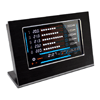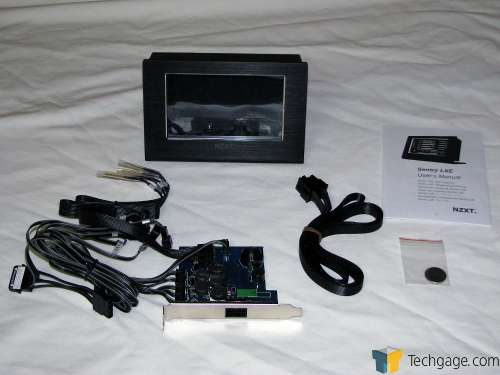- Qualcomm Launches Snapdragon 4 Gen 2 Mobile Platform
- AMD Launches Ryzen PRO 7000 Series Mobile & Desktop Platform
- Intel Launches Sleek Single-Slot Arc Pro A60 Workstation Graphics Card
- NVIDIA Announces Latest Ada Lovelace Additions: GeForce RTX 4060 Ti & RTX 4060
- Maxon Redshift With AMD Radeon GPU Rendering Support Now Available
NZXT Sentry LXE Touch-Screen Fan Controller

Although NZXT produces a wide-range of products, its fan controllers have become one of the highlights of its line-ups. The reasons are threefold: features, performance and price. We were left quite impressed with earlier Sentry models, and we can say that NZXT has done it once again with its Sentry LXE.
Page 1 – Introduction
Like all enthusiasts, I endeavor to maintain control over all aspects of my computer. I never run on auto settings, I never allow my software to work unattended and I keep a tight rein on all aspects of the cooling system. While it takes a bit of work and a fair bit of attention, I will always opt for the manual approach so that I have the final say on everything.
The next major concern of mine is noise abatement. I am forever thankful for the industry’s movement towards the quiet PC. Even just 5 short years ago, the enthusiast was forced to trade off their hearing in order to keep their overclocked monster from melting. I still have nightmares from one of my most memorable builds that housed 8 Vantec Tornado 80mm fans. It was nearly impossible to comfortably sit within 4 feet of the tower without earplugs. Ah, the good ole days…
Thankfully, companies such as NZXT have come to our rescue. With the release of the original Sentry 1 back in 2007, we were given a viable solution to fan control with a colorful interface. Next in line was the Sentry LX. Sporting a dual 5.25″ bay mounting design with a touch screen LCD for a control interface, the LX was like nothing else and got the job done with style. The Sentry 2 completes the list of previous releases by combining the Sentry 1 and the LX into a fantastic single 5.25″ bay design.
The latest incarnation for our reviewing pleasure again takes something old and combines it with something completely new to the market; an external interface. My main gripe over the years is that those (including me) who place their PC under their desk out of eyesight are forced to crane and stretch to keep watch on the fan controller and to manipulate settings. This revolutionary design of placing the touch screen controls on our desk just makes perfect sense to me and is long overdue. So with that said, let’s get the LXE out of the box and into the lab and see if it lives up to our high expectations.
Closer Look
Out of the box and on the bench we get a closer look at the LXE. Included in the package are the LCD unit, battery, and PCI based controller and operating instructions. One important note is that the PCI card does not actually use a PCI slot, so it only needs an open PCI expansion slot on the chassis to mount. The 8-pin cable that attaches to the LCD unit attaches to the external 8-pin port on the expansion card. All wires are numbered to correspond to which fan channel and which temperature monitoring channel they handle. There is plenty of length in all the cabling for even the largest of cases.
The LCD itself is housed in a brushed aluminum frame which is angled slightly to give you the best angle for viewing. There is a protective film on the screen that should be removed before using. The entire unit has some heft to it so it will have no issues sitting squarely on your desk and it won’t be easy to knock over. The build quality is excellent.
The expansion card also shows some advances over the previous models. With the ability to handle up to 10W per channel, there are few regular desktop fans out there that can overwhelm this controller. I also really like how NZXT insulated the regulators since some users had issues with noise from this area. There is also a mini speaker installed on the card which takes care of all the audio needs the LXE has such as the alarm as well as sounding when you are pressing the controls.
There are five temperature probes each with 2′ of wiring allowing you to place them in the area of the fan channel you wish to monitor. Each is a small diode and provides very accurate readings. While my sample had nothing included to affix them in place, a small piece of tape is all that is needed for the job. They are also all clearly marked with labels to identify which channel they are monitoring.
In order to power each fan the LXE provides five power connections of the 3-pin variety. They too are at the end of 2′ of wiring to allow for reaching the deepest depths of the largest cases out there. My only gripe here is that there is no provision for a 4-pin fan connector whether it is Molex or motherboard header style.
Now that everything is unwrapped and prepped, let’s get back to the bench and install everything and find out just how well this package works.
Support our efforts! With ad revenue at an all-time low for written websites, we're relying more than ever on reader support to help us continue putting so much effort into this type of content. You can support us by becoming a Patron, or by using our Amazon shopping affiliate links listed through our articles. Thanks for your support!









